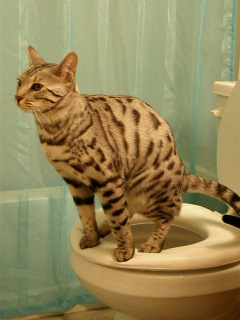Avoid Clogs and Damage: Never Flush Cat Poop Down Your Toilet - Professional Insights
Avoid Clogs and Damage: Never Flush Cat Poop Down Your Toilet - Professional Insights
Blog Article
What are your ideas on Don’t flush cat feces down the toilet?

Intro
As feline owners, it's essential to bear in mind exactly how we get rid of our feline buddies' waste. While it may appear practical to flush pet cat poop down the bathroom, this practice can have damaging consequences for both the setting and human health.
Alternatives to Flushing
The good news is, there are more secure and more liable means to deal with cat poop. Take into consideration the adhering to alternatives:
1. Scoop and Dispose in Trash
The most usual technique of dealing with feline poop is to scoop it right into a biodegradable bag and toss it in the trash. Be sure to utilize a committed clutter inside story and deal with the waste quickly.
2. Use Biodegradable Litter
Select naturally degradable feline trash made from materials such as corn or wheat. These litters are environmentally friendly and can be safely dealt with in the trash.
3. Hide in the Yard
If you have a backyard, take into consideration burying cat waste in a designated location away from vegetable gardens and water resources. Make sure to dig deep sufficient to prevent contamination of groundwater.
4. Set Up a Pet Waste Disposal System
Invest in a pet dog garbage disposal system specifically made for cat waste. These systems make use of enzymes to break down the waste, decreasing smell and environmental influence.
Health Risks
Along with ecological issues, purging cat waste can additionally pose health and wellness threats to humans. Feline feces might have Toxoplasma gondii, a parasite that can trigger toxoplasmosis-- a possibly extreme illness, especially for expectant ladies and people with weakened body immune systems.
Ecological Impact
Purging pet cat poop introduces hazardous microorganisms and parasites into the water system, presenting a substantial threat to marine ecological communities. These impurities can adversely influence aquatic life and compromise water quality.
Final thought
Responsible pet ownership extends beyond giving food and shelter-- it additionally includes correct waste administration. By avoiding flushing feline poop down the bathroom and selecting alternate disposal techniques, we can reduce our environmental impact and secure human health and wellness.
Why Can’t I Flush Cat Poop?
It Spreads a Parasite
Cats are frequently infected with a parasite called toxoplasma gondii. The parasite causes an infection called toxoplasmosis. It is usually harmless to cats. The parasite only uses cat poop as a host for its eggs. Otherwise, the cat’s immune system usually keeps the infection at low enough levels to maintain its own health. But it does not stop the develop of eggs. These eggs are tiny and surprisingly tough. They may survive for a year before they begin to grow. But that’s the problem.
Our wastewater system is not designed to deal with toxoplasmosis eggs. Instead, most eggs will flush from your toilet into sewers and wastewater management plants. After the sewage is treated for many other harmful things in it, it is typically released into local rivers, lakes, or oceans. Here, the toxoplasmosis eggs can find new hosts, including starfish, crabs, otters, and many other wildlife. For many, this is a significant risk to their health. Toxoplasmosis can also end up infecting water sources that are important for agriculture, which means our deer, pigs, and sheep can get infected too.
Is There Risk to Humans?
There can be a risk to human life from flushing cat poop down the toilet. If you do so, the parasites from your cat’s poop can end up in shellfish, game animals, or livestock. If this meat is then served raw or undercooked, the people who eat it can get sick.
In fact, according to the CDC, 40 million people in the United States are infected with toxoplasma gondii. They get it from exposure to infected seafood, or from some kind of cat poop contamination, like drinking from a stream that is contaminated or touching anything that has come into contact with cat poop. That includes just cleaning a cat litter box.
Most people who get infected with these parasites will not develop any symptoms. However, for pregnant women or for those with compromised immune systems, the parasite can cause severe health problems.
How to Handle Cat Poop
The best way to handle cat poop is actually to clean the box more often. The eggs that the parasite sheds will not become active until one to five days after the cat poops. That means that if you clean daily, you’re much less likely to come into direct contact with infectious eggs.
That said, always dispose of cat poop in the garbage and not down the toilet. Wash your hands before and after you clean the litter box, and bring the bag of poop right outside to your garbage bins.
https://trenchlesssolutionsusa.com/why-cant-i-flush-cat-poop/

I am very interested by Don’t flush cat feces down the toilet and I'm hoping you enjoyed reading the new blog post. Are you aware of somebody who is looking into the subject? Please feel free to promote it. Bless you for your time. Visit us again soon.
Website Report this page